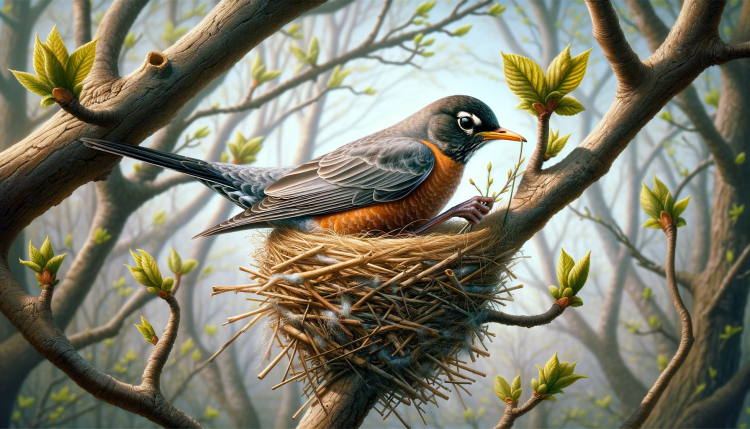
Quick Identification Guide for the American Robin (Turdus migratorius):
Appearance:
- Size: About 9 to 11 inches in length.
- Color: Gray-brown upperparts and a distinct orange or red breast. The head is darker, often appearing black.
- Beak: Yellow bill.
- Young Robins: Spotted with white and brown, lacking the distinctive red breast.
Behaviors:
- Foraging: Often seen hopping on lawns, looking for earthworms.
- Flight: A series of rapid wing beats followed by a quick glide.
Song:
- A series of clear whistles and chirps, often heard during early morning and evening.
Habitat:
- Found across North America in a variety of habitats including forests, parks, gardens, and urban areas.
- Common in backyards and open woodlands.
Birds Commonly Confused With:
- European Starling: Similar size but starlings have a more iridescent, speckled appearance and a shorter tail.
- Varied Thrush: Similar in size and shape but has a distinct orange line across its chest and face.
- Spotted Towhee: Similar size but has white spots on its back and sides, and a longer, darker tail.
Seasonal Behavior:
- Migratory bird, moving south for the winter, though some populations in milder climates may stay year-round.
- More likely to be found in suburban and urban areas during the winter.
The American Robin is one of the most common and recognizable birds in North America, noted for its distinctive coloring and melodious song. They are often seen on lawns and in gardens, making them a familiar sight in both rural and urban settings. Their adaptability to different environments makes them a ubiquitous presence across the continent.


Quick Facts About the American Robin (Turdus migratorius):
Family: Turdidae (the thrush family).
Size: About 9 to 11 inches long.
Coloration: Gray-brown upperparts, with a bright orange or red breast. White around the throat and a yellow bill.
Diet: Omnivorous, feeding on earthworms, insects, and various fruits.
Habitat: Found across North America, from Alaska and Canada to Mexico. Adaptable to a variety of habitats including forests, fields, gardens, and urban areas.
Nesting: Often nests in trees, shrubs, or even on building ledges. The nest is a cup-shaped structure made of grass and mud.
Eggs: Lays 3-5 blue eggs, known for their distinctive color.
Behavior: Known for their early morning singing and foraging on lawns for earthworms.
Migration: Partially migratory, with northern populations moving south in winter, though some individuals stay in milder climates year-round.
Cultural Significance: Considered a harbinger of spring in many areas and a symbol of cheerfulness and joy.
Conservation Status: Listed as of ‘Least Concern’ by the IUCN, with a wide distribution and large population.





